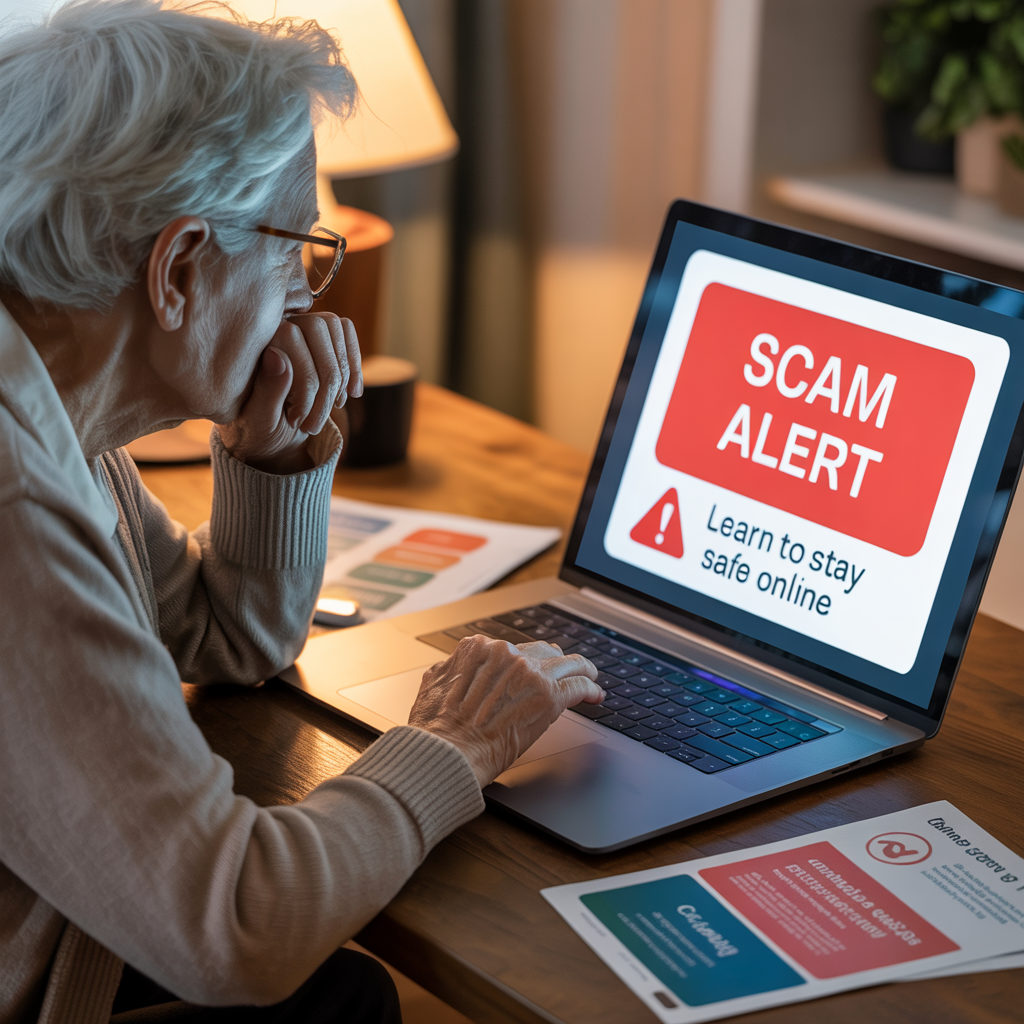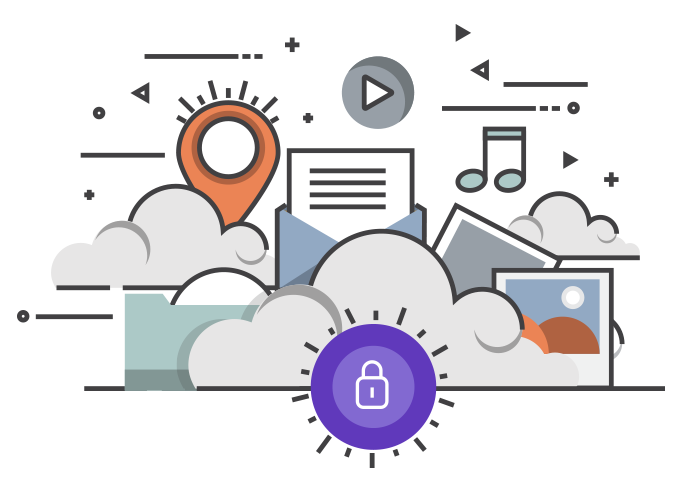💡 DIY Computer Fixes?
Grab my easy step-by-step guide and keep your computer running like new.
Online scams targeting seniors have become more convincing than ever, and unfortunately, they’re designed to fool good, honest people by triggering fear and urgency. I talk with seniors every single day who tell me, “This looked so real — anyone would have believed it.” And they’re right. If you’re new here and want to know more about who’s giving you this advice, you can learn about my approach on my Honest Computer Repair page, which explains why seniors nationwide trust me for safe and patient technology help.

Staying informed is the easiest way to avoid tech scams.
- Tip #1 — Slow Down Before You Click Anything
- Tip #2 — Never Trust the Caller ID or Email Sender Name Alone
- Tip #3 — Never Call the Phone Number Inside a Warning Message
- Tip #4 — Protect Your Personal Information the Easy Way
- Final Tip — Don’t Be Embarrassed to Ask for Help
- Awareness is not weakness — it’s protection.
Tip #1 — Slow Down Before You Click Anything
Every tech scam has one thing in common: urgency.
If something is trying to force you to act right away — click now, call now, verify now, pay now — that is your biggest red flag.
Scammers use panic the same way fishermen use bait. The more worried you are, the less likely you’ll stop and think it through.
A real company will never punish you for slowing down.
Even your bank would rather you be cautious than rushed.
Quick rule you can use immediately:
If it feels rushed, it’s suspicious.
Here are a few real examples I see constantly when helping seniors:
| Scam Scenario | What They Try to Make You Feel |
|---|---|
| “Your account will be locked in 24 hours unless you verify now” | Panic |
| “There has been fraud on your account — urgent call” | Fear |
| “You missed a delivery — click to reschedule” | Pressure |
| “Your computer is infected, call support immediately” | Alarm |
Legitimate companies don’t give threats inside an email or a text.
If something is real — you’ll be able to confirm it by going to the company directly (not clicking their link).
Tip #2 — Never Trust the Caller ID or Email Sender Name Alone
This one surprises a lot of people: your phone can show a call as “Social Security” or “Bank of America” — even when it’s actually a scammer.
The same thing happens with email. The name can say “Amazon Billing,” but when you click the actual address, it turns out to be something like:
That is the scam giveaway.
Real companies use simple email addresses like:
If there are extra words, dashes, typos, or a weird country ending — it’s fake.
👉 This problem has become so widespread that the Federal Trade Commission warns seniors not to trust caller ID anymore.

A quick pause and second look are often all you need to avoid a scam.
Tip #3 — Never Call the Phone Number Inside a Warning Message
This trick is extremely common now — especially the fake Microsoft and Amazon alerts. A message pops up and tells you your computer is infected and gives you a number to call.
That number doesn’t go to Microsoft.
It goes directly to the scammer.
I’ve helped countless seniors who were seconds away from giving a stranger access to their entire computer — all because the popup looked real. Some scammers even trigger loud alarm sounds or flashing screens so it feels urgent.
The key to avoiding this is simple:
If the warning provides a phone number, it is fake.
Real companies do not show virus warnings with phone numbers.
And if you ever do want real help from someone you can trust, you can always reach out to me at That Tech Jeff, where I offer safe, affordable remote help — and I never charge if the news is bad or the problem isn’t fixed.
The “Legitimate or Scam?” 5-Second Test
Whenever something suspicious appears, ask yourself these:
| Question | If Yes | If No |
|---|---|---|
| Is it trying to scare or rush me? | Likely scam | More likely real |
| Does it give a phone number to call? | Scam | Real companies don’t do that |
| Does it ask for passwords/codes? | Scam | Real companies never do |
| Does it claim you owe money immediately? | Scam | Real billing has statements |
| Did it contact you first? | Scam 90%+ of the time | Real if you initiated |
If you run through this checklist, you will avoid 99% of fraud attempts instantly — and you’ll do it without fear, just awareness.
Tip #4 — Protect Your Personal Information the Easy Way
You don’t need complicated security tools to stay safe — you just need one simple rule:
Never give personal or financial information to someone who contacted you first.
If you initiate the call or login (by typing the website address manually yourself), you’re fine. If they reach out to you first — email, text, popup, or phone — assume it’s fake until proven otherwise.
A few examples of “information requests” that are always scams:
-
“Confirm your Social Security number”
-
“We need remote access to your computer to remove a virus”
-
“Give us your bank login to verify a charge”
-
“Please read me the code we just texted you”
That last one is a huge growing scam — cybercriminals try to “recover” your own account while pretending to be the company helping you. They ask you for the code because it makes them, not you, the owner of the account.
Simple Everyday Habits That Keep You Safe
Here are a few low-effort habits that dramatically reduce scam risk without making your computer harder to use:
| Habit | Why It Helps |
|---|---|
| Type the website address instead of clicking links | Bypasses fake login pages |
| Let suspicious calls go to voicemail | Stops “pressure” tactics |
| Ask someone you trust to double-check | Two sets of eyes = calmer decision-making |
| Slow down before clicking | Eliminates “panic clicks” |
Additional Resource Links for Seniors (External)
Here are three more trustworthy sources seniors can bookmark for scam-prevention help:
AARP Fraud Watch
USA.gov Scam Alerts
Microsoft’s Real Tech Support Guidelines
How I Help Seniors Avoid Tech Scams (Internal Links Included Below)
The #1 thing I hear from seniors I help is:
“I just wish I had someone I could quickly ask before clicking anything.”
That’s exactly what I provide — safe, friendly tech help from someone who has spent 15+ years helping seniors nationwide, with more than 1,400 five-star reviews.
To help seniors feel confident online, I offer no-charge scam checks — I’ll review anything suspicious before you click it, at no cost, so you never have to wonder or worry.
Here’s where you can learn more about me and my service:
Why I’m a better alternative to Geek Squad
Senior-recommended computer help
Remote computer help for seniors
If you’re ever unsure — even for a second — whether something is safe, you can send it to me first before clicking or calling anyone.
There’s no charge to check if something is a scam. I’ll gladly look at it for you and give you peace of mind.
That way, you never have to feel rushed or alone when something suspicious pops up.
Final Tip — Don’t Be Embarrassed to Ask for Help
Scammers depend on silence and embarrassment.
Awareness is not weakness — it’s protection.
The people most likely to get scammed are not “unskilled computer users.”
It’s the people who hesitate to ask for help.
Asking for a second opinion is a strength — and it works.
The safest seniors online are not the ones who know the most about technology…
They’re the ones who pause before they click and say:
“Let me have someone double-check this first.”
And I am more than happy to be that “someone” for you.
Today’s scams are designed to look professional and believable — so if you’ve ever come close to falling for one, you are absolutely not alone. The difference going forward is that now you know exactly what warning signs to look for and how to respond confidently.
You don’t need fear — just awareness.
Slow down.
Verify outside the message.
Never call the number inside the alert.
And if anything feels questionable, send it to me — no charge, no pressure, no upsell.
That’s how seniors avoid tech scams — calmly and confidently.


